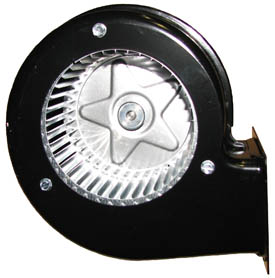Part 5 Description - 3100 Series
 Core Blower
Core Blower
When the system receives a heat call, the supply air blower is energized and circulates air through the duct system and into the home. The discharge air sensor monitors the discharge air temperature. If the discharge air temperature (as set in L048 and L049) is not being reached, the core blower is energized and circulates air through the brick core. This heated air is mixed with the return air to maintain the desired temperature. If the front air channel is not installed properly, the core blower will operate; however, will be unable to extract heat from the brick core.
Core blower speed is determined by the amount of voltage sent to the blower from the base I/O relay board. As the fan speed requirements increase, voltage to the blower increases. Refer to Location 112 (L112) for the current discharge air temperature and Location 120 (L120) for the current core blower speed. Check voltage AC from the L2 terminal to the blower terminal on the base I/O relay board and compare this reading to the Blower/Damper Activation Chart.
Early blower motors had sleeve type bearings that were permanently lubricated. Steffes does not recommend oiling these motors; however, if desired, a motor can be re-oiled with SAE 20 oil. Over oiling the motor can cause motor failure! Later blowers were equipped with ball bearings. These motors are not intended to be lubricated.
Vibration of the blower can be caused by a build up of dirt and debris. If there is a noise issue, clean the blower wheel and verify that the blower is mounted properly. All motor windings must have at least 20 meg ohms of resistance from each of the leads to ground. Resistance across the motor leads should be as shown in the table below.
|
Type |
240V |
|---|---|
|
Fasco |
60-75 |
|
PTech Multi-Tap |
160-210 |
For more information on troubleshooting the core blower, replacing the core blower, or ordering replacement parts, refer to the links below: